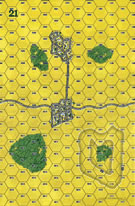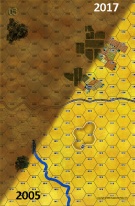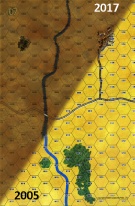|
Rescuing the 80th Fronte Russo #10 |
||
|---|---|---|
| (Attacker) Italy | vs | Soviet Union (Defender) |
| Formations Involved | ||
|---|---|---|
| Italy |  |
3º Reggimento Bersagliari |
| Italy |  |
5º Reggimento Cavalleria "Lancieri di Novara" |
| Italy |  |
63º Battaglione Camicie Nere |
| Italy |  |
63º Legione Camicie Nere “Tagliamento” |
| Italy |  |
79º Reggimento Fanteria "Roma" |
| Italy |  |
9ª Divisione Fanteria "Pasubio" |
| Italy |  |
XVIII Battaglione Bersaglieri |
| Italy |  |
XX Battaglione Bersaglieri |
| Soviet Union |  |
74th Rifle Division |

|
| Overall Rating, 3 votes |
|---|
|
4
|
| Scenario Rank: --- of 964 |
| Parent Game | Fronte Russo |
|---|---|
| Historicity | Historical |
| Date | 1941-11-12 |
| Start Time | 08:30 |
| Turn Count | 32 |
| Visibility | Day |
| Counters | 147 |
| Net Morale | 1 |
| Net Initiative | 2 |
| Maps | 6: 1, 2, 21, 5, 7, 8 |
| Layout Dimensions | 86 x 84 cm 34 x 33 in |
| Play Bounty | 172 |
| AAR Bounty | 161 |
| Total Plays | 2 |
| Total AARs | 2 |
| Battle Types |
|---|
| Breakout |
| Rescue |
| Urban Assault |
| Conditions |
|---|
| Off-board Artillery |
| Reinforcements |
| Severe Weather |
| Terrain Mods |
| Scenario Requirements & Playability | |
|---|---|
| Eastern Front | Maps + Counters |
| Fronte Russo | Base Game |
| Road to Berlin | Maps |
| Introduction |
|---|
|
After the capture of Gorlovka in the first days of November, the only relevant town in the sector still in Soviet hands was Nitikovka. Colonello Chiaramonti, commander of the 80th Regiment of the Pasubio Division, seized the initiative and marched toward it. Taking Nitikovka would reduce the gap between the Italian CSIR and the German XVII Army, located approximately 50 km north. Chiaramonti met increasing opposition during his march and lost contact with the main Italian force, but pushed forward all the same. As a result, when the 80th reached Nitikovka they came under siege by Soviet forces and soon became bottled up in the central part of town. They repulsed all Soviet attacks, but ran so low on ammunition that they could not hope to make their way back to Italian lines on their own. Forces from the main Italian lines made several unsuccessful attempt to break the siege, and the final effort came on November 12th. |
| Conclusion |
|---|
|
The relief force included many CSIR units that had been attached to the 3rd Bersaglieri Regiment for this mission. Most of the 8th Artillery Regiment provided support, as well as a squadron of Macchi 200. This time the Italians were able to make a dent in the defenses, but stiff Soviet opposition made the advance costly. The Italians took more than 400 casualties before the 79th Regiment was able to infiltrate Nitikovka and re-establish contact with the 80th at 1430 hours. To avoid further casualties, the Italians in town waited until nightfall and then withdrew under cover of a snowstorm. |
| 3 Errata Items | |
|---|---|
| Scen 10 |
Soviet Troops CAN NOT set up in the town on Board 2. Only outside. This is to represent the 80th (who are not on the board in counters) holding the centre of the town. During the game the Soviets can only enter town hexes on board 2 that are edge of town hexes. (Shad
on 2010 Apr 29)
|

|
The reduced direct fire value in Kursk: Burning Tigers is 4-4. (plloyd1010
on 2015 Jul 31)
|

|
Kommissars never get morale or combat modifiers. Ignore misprints. (Shad
on 2010 Dec 15)
|
| Rescuing The 80th | ||||||||||||||
|---|---|---|---|---|---|---|---|---|---|---|---|---|---|---|
Fronte Russo Scenario No.10 Nitikovka 12th November 1941 Scenario played : 7th March 2009 After the capture of Gorlovka in the first days of November, the only relevant town in the sector still in Soviet hands was Nitikovka. Colonello Chiaramonti, commander of the 80th Regiment of the Pasubio Division, seized the initiative and marched towards it. Taking Nitikovka would reduce the gap between the Italian CSIR and the German XVII Army, located approximately 50km north. Chiaromonti met increasing opposition during his march and lost contact with the main Italian force, but pushed forward all the same. As a result, when the 80th reached Nitikovka they came under siege by the Soviet forces and soon became bottled up in the central part of town. They repulsed all Soviet attacks but ran so low on ammunition that they could not hope to make their way back to the Italian lines on their own. Forces from the main Italian lines made several unsuccessful attempts to break the siege, and the final effort came on November the 12th. For this final effort, battalions from the Bersigliari, Blackshirts, Cavalry and Infantry regiments were used. They had a long road ahead of them. Around 6 or 7km of territory criss-crossed with railway embankments and heavily defended by numerous Soviet units. They would therefore need to not only to advance over this, reach and relieve the town and leave a corridor open all the way back to safety, but also do this losing a minimum of casualties to have made the task worth while. At 0830 hours the attack begun along a broad front. The Italian units, though pushing north, veered westward in order to achieve a greater concentrated effort on their left flank. The first main obstacles encountered were a defended hill position left-centre of the line and a forward woods position on the left flank. Attacks against these begun around 0930. Using artillery support and excellent move and fire tactics, the Soviets were strangely, but easily pushed from the hill with quite a few casualties inflicted. The defenders in the woods made an orderly withdrawal and kept their cohesion. These early successes made it much easier for the Italians to push on over the next 2kms. As they did so, the Russians were forced to reel back and spent much time trying to re-align their defensive line. This was made all the more difficult as a reserve of a Blackshirt and Bersigliari battalion were pushed through the centre. On their western flank, the Soviets were holding out in the thick wooded country plenty well. But up the middle and to the east flank, their troops had to scurry back and in a pretty much chaotic style, harried as they were by artillery tearing through the ranks and the Italian reserve already mentioned. A defensive line was set by the Soviets in front of Nitokovka, and this held up the Italian advance for some time. This was also helped by the Soviets over on the wooded east flank. Their positions meant that the Italian SCIA had to fight through channelled openings and restricted the speed as well as the cohesion of the advance. The fighting at the line in front of the town did result in the loss of the life of the Soviet senior officer, a Colonel. His death signalled a further retirement, this time towards the town’s outskirts itself. By 1300 hrs and four and a half hours of battle, Soviet casualties had far outstretched the attackers. Some 500 losses or more had been left strewn in the fighting before Nitokovka. Less than 80 Italians had fallen. With the town before the Italians now, the final assault had to be launched. The Italians had collected their best troops in front of the town, made up mainly of the XVIII & XX Bersigliari as well as some high morale platoons of Blackshirts from the Tagliamento Battalion. However, behind them and all the way back for some 6km were numerous units strung out and left guarding the corridor, or simply lagging behind in the assault. These positions would prove very important to the final outcome. The Italians laid down their artillery on the defending Soviets on the outskirts of Nitokovka and surprisingly, they buckled very quickly. A rapid and vicious assault was launched and a hole was soon opened in the defence. Into this poured the attackers, and the 80th had finally been reached. Italian casualties though had just started to rise. Little known to those at Nitokovka though was the fact that Soviet assault groups began making their own vicious counter-attacks at rear echelon units in the Italian positions. Suddenly, lone platoons, or vulnerable units soon became the focus of a Soviet force needing to inflict damage after losing their position. Far back in the rear, two companies of Russian troops found themselves in a position to send down shells from their artillery reserves on the vulnerable and open emplacements of Italian mortar teams. Before the Italians could move, much carnage was caused by the bombardment. Attacks like these added to the Italian casualty list at an alarming rate. At one point, a whole platoon of Blackshirt infantry disappeared under the massed guns of bombardment. By 4pm, it was realised that despite the heroic relief of the 80th, the foray had cost too many Italian soldiers their lives. Yes, the 80th were free, and yes, a clear route back had been kept open. But the loss of 340 men proved too much a loss in exchange for that relief. For their part, Soviet losses amounted to just less than 800 men, and though granted a victory, it must have felt very hollow for those that survived. |
||||||||||||||
| 0 Comments |
| Rescuing the 80th? | ||||||||||||||
|---|---|---|---|---|---|---|---|---|---|---|---|---|---|---|
Excellent scenario. In our battle Vince did really well as he advanced towards the town where the 80th were trapped. As the Soviet player I kept pulling back to new defesnive lines which the Italians either flanked or pushed thru. However the VC conditions are tough for the Italians and while I though they could push through to the town I planned to counter attack and either cut the corrider from the south edge to the town or cause 15 steps worth of casualties. As Vince says he had left some units behind which were very vunurable and I swooped on these and managed to snatch a win. |
||||||||||||||
| 0 Comments |

 FrRu009
FrRu009 



































